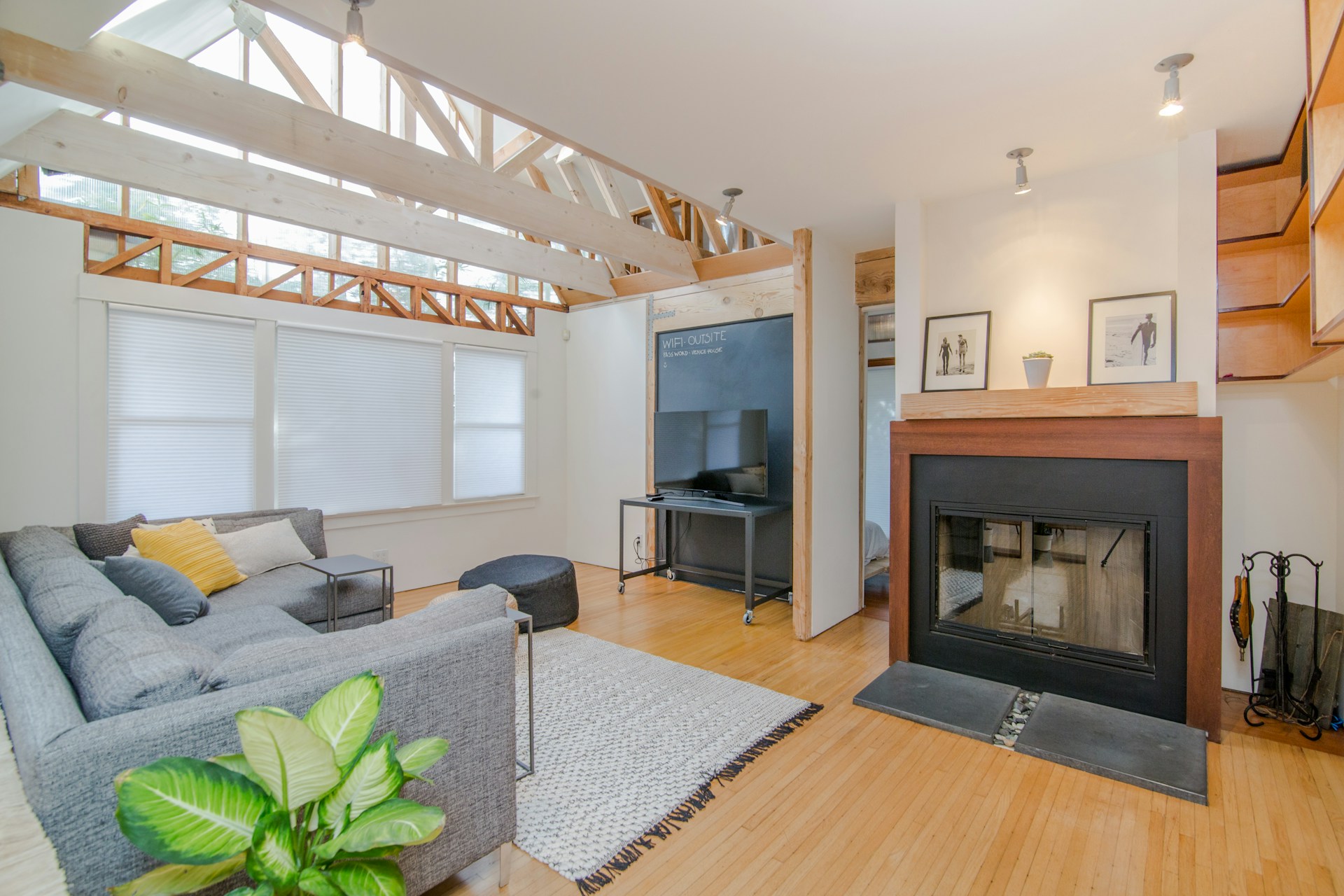What is coliving and how does it work?
Everything about coliving: what it is and how it works. Discover the ins and outs of the most popular type of accommodation among digital nomads!
You’ve probably heard of them. These types of accommodation for digital nomads, students, and others who need an efficient housing solution are becoming more common. In fact, a study by Cushman & Wakefield, estimates that the sector will reach a turnover of 550 billion globally in the coming years. But what exactly are they? Who lives in them? What do they offer? Today, we want to help clear up any doubts you might have about these spaces. We’ll explain what coliving is, how it works, and how to stay in one.
We’ll also go over the key elements that define these spaces and the services that make them unique. If you’re looking for accommodation that combines practicality, community, and flexibility, keep reading because they’ll likely meet your expectations.
What is coliving?
Coliving is an accommodation model that combines private spaces with shared areas designed to encourage coexistence, collaboration, and connection among residents. It’s not just about sharing a roof; it’s about living in an environment created for people who seek community and comfort. This concept is ideal for digital nomads, entrepreneurs, or international students. It integrates work, leisure, and social life in one place.
In these spaces, each resident has their own area to rest or work without interruptions. At the same time, shared spaces such as coworking areas, communal kitchens, and recreational areas provide opportunities to socialise, collaborate, and exchange ideas. This combination allows for a balance between moments of peace and spaces designed to connect and collaborate with others.
Colivings also offer a functional environment in some of the best destinations for digital nomads, students, and remote workers. They stand out for including services that simplify daily life, such as cleaning, maintenance, and high-speed internet. But they don’t stop there. To encourage personal and professional growth, they organise social activities, workshops, and cultural events.
The popularity of this type of accommodation has been increasing due to the demand for a more flexible and dynamic lifestyle. They are usually located in strategic areas, close to work centres, leisure, or public transport. In a world where remote work and international mobility are the norm, this form of accommodation not only meets practical needs but also offers an enriching experience.
If the idea of living in a space that combines independence, community, and services designed to enhance your well-being appeals to you, coliving might be just what you’re looking for. Let’s take a closer look at how this model works and what makes it one of the most interesting trends of the 21st century.
What does a coliving consist of?
As you can infer from the previous section, a coliving is not just a building with shared rooms; it’s an ecosystem designed to offer comfort, functionality, and a sense of community. These spaces meet the essential needs of residents while encouraging interaction and collaboration.
Every corner within a coliving has a clear purpose. Private spaces offer the peace needed for rest and work. Shared areas create the perfect environment for sharing moments, collaborating on projects, or socialising.

The rooms: Your personal retreat
Rooms in a coliving are designed to provide a space of privacy within a communal environment. Typically, these are single rooms or fully equipped studios, with a bed, desk, wardrobe, and in many cases, a private bathroom. This design aims to combine functionality and comfort. It caters to those who need a quiet place to rest as well as those who prefer to work from their own space.
Although the size may be smaller than a traditional apartment, the quality of the furniture and attention to detail in the design make up for it. Many rooms in modern colivings follow a minimalist style, focusing on natural light and sustainable materials. This balance between practicality and aesthetics turns each room into a true personal retreat, ideal for unwinding after a productive day.
Coworking: The space for your productivity
This is one of the key aspects of any coliving. These areas are designed to maximise productivity and creativity. Equipped with ergonomic desks, comfortable chairs, and high-speed internet connection, they perfectly meet the needs of digital nomads, remote workers, and entrepreneurs. Moreover, they often feature natural lighting, private meeting rooms, and collaborative spaces to foster the exchange of ideas among residents.
Some colivings go even further, offering technological tools such as 3D printers, interactive whiteboards, or video conferencing stations. This focus on functionality makes coworking spaces the ideal place not only to work but also to connect with a professional community that shares your interests and goals.
Shared kitchen: The heart of the coliving
The shared kitchen is more than just a place to prepare food; it’s a meeting point where residents share moments, recipes, and stories. These spaces are fully equipped with modern appliances, kitchen utensils, and ample surfaces to work on.
In addition to functionality, these areas often feature large tables where residents can enjoy their meals together. This type of interaction fosters a sense of community and makes something as ordinary as cooking a social experience. In some colivings, themed dinners or cooking workshops are even organised to bring members closer together.
Leisure and recreation areas: Relaxation at your fingertips
Leisure and recreation areas are essential to balance residents’ daily routines. In these spaces, designed for rest and fun, you might find everything from lounges with sofas and TVs to outdoor terraces where you can enjoy a relaxing afternoon. Some colivings also offer gardens, pools, gyms, or even meditation rooms.
They don’t just invite rest; they also create opportunities for spontaneous socialising with other residents. Whether it’s sharing a board game, watching a movie, or practising yoga outdoors, these leisure areas foster a sense of belonging and community.
Event areas: Connect with the Community
Event areas are the epicentre of community activities within a coliving. These multifunctional spaces can host workshops, meetings, networking sessions, or even movie nights and live music. Equipped with projectors, sound systems, and versatile furniture, they can adapt to a wide range of needs, allowing residents to interact and collaborate.
In addition to strengthening bonds among members, these areas are perfect for sharing knowledge and learning from others. Some colivings schedule regular activities, such as inspiring talks or group classes. Others allow residents to organise events based on their own interests.
How does a coliving work?
It sounds very different from other forms of accommodation, right? Here’s one last difference you’ll like even more: it’s very easy to settle in. No complicated contracts, no deposits, and no complex paperwork.
To give you an idea of the process, let’s go over the steps you’ll follow if you choose this type of accommodation. Knowing these details will help you understand why this model is ideal for those seeking comfort, interaction, and flexibility in one place.

1. Application and reservation
The first step to finding your ideal coliving is to search online. Through specialised coliving platforms, you can explore available options in the city you want to move to. Companies like Selina or Outsite offer intuitive systems to filter by location, cost, or specific services. Once you find an option you like, you can submit your reservation request through their website or app.
They will ask for basic details, and in most cases, you’ll need to make an initial payment to confirm your stay. Since the collaborative spirit is one of their main features, some colivings include a brief interview as part of the booking process. Remember that with your Holafly monthly plans, you can stay connected no matter where you are, which makes booking a coliving at your next destination much easier.
2. Entering the coliving
When you arrive, they’ll give you a tour of the place. During this initial walkthrough, they’ll explain the basic rules, schedules, and common areas you can use. Some colivings assign a “mentor” or manager who can answer questions or help you integrate into the community.
You’ll receive physical or digital keys. You’ll also get access to the technological tools of the place, such as apps to manage bookings of common spaces or community activities.
3. Stay and use of services
During your stay, you’ll have access to basic services like regular cleaning, maintenance, and high-speed internet. As mentioned earlier, the shared spaces—such as coworking areas, kitchens, and recreational zones—help with daily tasks and encourage interaction with other residents.
Organised activities are another key point. Workshops, movie nights, cultural events, and networking sessions are common in colivings. This creates a dynamic and enriching environment where you can meet people with similar interests or even build professional connections.
4. Renewal or ending of the stay
Many colivings offer flexible stay plans. If you decide to stay longer, they usually allow you to renew your contract with minimal paperwork. Some places even offer discounts or additional benefits.
If you choose to end your stay, the process is simple. You only need to notify them in advance to arrange the room handover and ensure everything is in order.
5. Leaving the coliving
When it’s time to leave the coliving, the staff will help make the transition smooth. This includes returning keys, checking the condition of your private space, and, in some cases, completing surveys to provide feedback on your experience.
Coliving Users
You might be wondering whether you’d fit in this type of accommodation. In reality, colivings are designed to cater to a wide variety of lifestyles. They’re a suitable option for people with different needs and goals. Although the concept is flexible, most residents share a common interest: combining comfort, community, and functionality in their daily lives.
Let’s take a look at who the main users of colivings are and why they consider these spaces the perfect solution for their lifestyle. Each group enjoys specific benefits that help them thrive both personally and professionally.

Digital nomads
First, we must mention digital nomads. They are one of the primary groups that choose coliving. These people work remotely while travelling, and they find everything they need for their itinerant lifestyle in these spaces. Coworking areas with high-speed internet and social activities help them build a network wherever they go. They also benefit from accommodation that doesn’t require deposits or involve exorbitant prices.
The flexibility of colivings—both in the duration of the stay and the location—is another key point for digital nomads. Without dealing with complicated rental contracts or searching for workspaces, they can focus on their productivity and enjoy their overall experience.
Important: If you are a frequent traveler and want to stay connected without worrying about expensive roaming or looking for a new SIM at every destination, Holafly’s subscription plans are for you. With a single eSIM, enjoy internet in more than 170 countries for a fixed price and no surprises on your bill. Travel without limits and connect easily and securely! 🚀🌍

International students
Finding accommodation as a student can be quite complicated. You often don’t know the areas and neighbourhoods of the city you’re moving to, and on top of that, many landlords aren’t willing to rent to people without a work contract. Students who move abroad to study and work, often choose colivings for these reasons and more. They look for a safe, social, and comfortable place.
They also value the shared areas and organised activities, which help them integrate more quickly into a new culture. These spaces allow them to meet other students or professionals with similar interests. Colivings also eliminate the stress of managing basic services like cleaning, maintenance, or internet access. This gives them more time to focus on their studies and enjoy the experience of living in another country.
Entrepreneurs and freelancers
For entrepreneurs and freelancers, colivings are more than just a place to live; they are a source of inspiration and collaboration. Well-equipped coworking spaces and community activities offer opportunities for networking and creating professional synergies.
Being surrounded by like-minded people helps foster creativity. It also allows them to explore new ideas. Shared spaces, like kitchens or recreation areas, become informal places where unexpected collaborations can arise.
Older adults
Although it might surprise you, more and more older adults are choosing colivings as a modern form of co-living. These spaces allow them to live independently while still being part of an active community.
The included services—such as cleaning and maintenance—eliminate logistical concerns. Meanwhile, the organised activities and shared areas offer a dynamic and enriching environment. For those seeking a balance between privacy and company, coliving is an ideal option.
People in transition
Colivings are also perfect for people in transition, such as those moving for work, going through life changes, or needing a temporary place while they figure out their next steps. The flexibility and included services make this model a practical solution.
By removing long-term contracts and the need to manage basic services, colivings help these residents adapt quickly to new situations. The community environment also provides support and the chance to build new personal or professional connections.
How to rent or book a coliving
As we mentioned earlier, booking a room in a coliving is much simpler than renting an apartment or any other form of accommodation. They are designed to make life easier for their guests, and that includes a smooth and simple leasing process. Since most are managed online, everything becomes even easier. While each company has its own specifics, here’s what you need to know if you want to move into one of these spaces:

Plans and stay options
One of the great advantages of colivings is the flexibility they offer their residents. Unlike traditional rentals, here you can choose plans that suit your lifestyle. They work for temporary stays linked to a specific project or for longer stays if you want to settle down. You can opt for:
- Short stays: Ideal for those seeking temporary accommodation while exploring a destination or working on a specific project.
- Long stays: Designed for users who want to stay for several months or even years, often with reduced rates.
- Flexible plans: These allow you to adjust the length of your stay according to your needs, with no significant penalties for changes.
Coliving prices usually include services like cleaning, maintenance, internet access, and access to common areas. This removes extra worries and simplifies daily life.
For example, Inèdit Barcelona, one of the best colivings in Barcelona, offers private rooms with shared work areas at prices ranging from €600 to €900 ($649 to $974) per month. The amount varies depending on location and included service.. In Madrid, Outsite offers similar rates and has the advantage of being located in central neighbourhoods, which is ideal for international professionals and digital nomads.
Reservations and payments
Booking a coliving is usually done through the official website or app of the chosen space. The initial payment, which is generally a percentage of the total stay cost, confirms your booking and secures your spot. Many platforms accept modern payment methods, such as credit cards, bank transfers, or even cryptocurrencies.
Additionally, some colivings allow payments to be split into monthly instalments. This financial flexibility is one of the reasons coliving appeals to digital nomads and other users who seek a balance between quality and cost.
Basic requirements
Although requirements may vary depending on the coliving, the most common ones include:
- Personal identification: A valid ID or passport.
- Initial payment or deposit: To secure your booking and cover potential incidents.
- Commitment to the community: Some applications include a basic agreement on the coliving’s rules and values.
In some cases—especially in colivings aimed at professionals or digital nomads—you may be asked for information about your occupation or current project. This helps ensure a harmonious coexistence among residents.
Renewal or changes to the contract: Flexibility guaranteed
One of the biggest advantages of coliving is the possibility to renew or adjust your contract according to your needs. If you decide to stay longer, you can extend your stay through the same platform where you made your booking. On the other hand, if you need to end your contract early, the terms are usually more flexible than traditional rentals, with clear and transparent policies.
Companies dedicated to renting coliving spaces
The rise of coliving has led to the creation of numerous companies specialising in this type of accommodation. They offer solutions tailored to the needs of digital nomads, students, entrepreneurs, and anyone interested in a community living experience. These companies stand out for their comprehensive services and space design. They also make booking and managing stays globally very easy. We’ve gathered some of the most recognised worldwide:
Selina
Selina is one of the most well-known brands in the coliving world, especially among digital nomads. With a presence in over 25 countries, their spaces combine accommodation, coworking, and social activities in both urban and natural destinations. In addition to offering private and shared rooms, Selina organises activities such as yoga classes, creative workshops, and networking events to foster interaction among residents.
Outsite
Outsite is designed for those who need a quiet and productive space while exploring new destinations. With locations in America, Europe, and Asia, this company emphasises the minimalist and functional design of its spaces, as well as high-speed connections to facilitate remote work. It offers some of the best coliving options for digital nomads, remote workers, and people seeking community in their new destinations.
It offers memberships that allow users to access any of its properties worldwide, fostering a flexible, unfettered lifestyle. Furthermore, their spaces are ideal for those who value privacy and comfort while enjoying communal areas to socialise.
Common
Common focuses on providing coliving solutions in major cities in the United States, such as New York, San Francisco, and Los Angeles. Their offering combines access to fully furnished apartments with services like weekly cleaning, high-speed WiFi, and community activities.
They stand out for their attention to detail in design and the integration of technology to simplify urban living. Additionally, Common offers long-term stay options, making it a great choice for those seeking stability in big cities.
The Collective
The Collective is one of the pioneers in the coliving concept. Their spaces, combining modern design with a focus on sustainability, offer everything from private rooms to fully equipped studios. They also have a regular programme of cultural events, workshops, and social activities.
History and evolution of coliving

The concept of coliving did not appear out of nowhere. While it has gained popularity in recent years among digital nomads, entrepreneurs, and international students, its roots go back to much older forms of communal living. Throughout history, the need to share resources and spaces to maximise economic and social benefits has shaped this model of communal living that we now know as coliving.
Origins
Modern coliving has its roots in traditional forms of communal living. From ancient times, people have shared spaces and resources to reduce costs and foster mutual support. Examples include Israel’s kibbutzim, which emerged in the 20th century as self-sufficient communities based on cooperation. In Europe, during the 19th century, boarding houses offered shared accommodation to workers and students looking for an economical solution.
Additionally, in the 1960s and 1970s, countercultural movements like hippie communes advocated for communal living based on collaboration, sustainability, and rejection of individualism. While these initiatives differed from today’s colivings in their purpose and structure, they set a precedent for showing how shared spaces could transform how people live and relate to each other.
At the end of the 20th century, globalisation and rising property prices in major cities led to new forms of shared living, such as shared houses for students and young professionals. These experiences paved the way for the development of coliving as we know it today.
Emergence and evolution to the present day (2025)
Coliving, as we’ve described in this article, began to take shape in the early 2010s, driven by the rise of remote work, digitalisation, and the increasing need for flexibility in lifestyles. Companies like The Collective and Common began developing spaces that combined private rooms with shared areas and services designed to promote community, laying the foundations for contemporary coliving.
In its early stages, coliving mainly targeted young professionals seeking a practical and affordable living solution in large cities like New York, London, or Berlin. However, over time, this model evolved to serve a broader audience, including digital nomads, international students, and older adults looking for a more social life.
Between 2020 and 2025, coliving experienced exponential growth due to the COVID-19 pandemic, which changed perceptions of remote work and life priorities. Companies like Selina and Outsite expanded their global reach, offering spaces in both urban and rural destinations. At the same time, technological improvements, such as the introduction of digital tools to manage bookings and community activities, made this way of life more accessible and efficient.
In 2025, coliving is much more than a space to share housing: it’s an experience designed to meet the needs of a generation that prioritises community, sustainability, and flexibility.
Frequently asked questions about coliving spaces
Yes, both terms refer to the same concept. “Coliving” and “co-living” are variations used interchangeably to describe spaces designed to combine private housing with communal areas and a community experience. While the more common term is “coliving”, you may find both used in different regions or contexts.
It depends on the coliving. Some offer meal options as part of their services, like communal breakfasts or themed dinners, while others simply provide fully equipped shared kitchens for residents to prepare their own meals. It’s important to check the services included when booking.
No, although they share certain elements, they are different concepts. Coliving is designed for more flexible and temporary stays, with integrated services that make daily life easier for residents. On the other hand, cohousing involves a more stable, long-term community, where residents are typically owners or co-managers of the space and actively participate in decision-making.
Colivings are designed for a wide variety of people, including digital nomads, international students, entrepreneurs, young professionals, and anyone looking for a combination of privacy and community. Some colivings even have specific focuses, such as spaces for creatives or startups.
It depends on the destination and the services included in the coliving. While the cost of a coliving may be similar to or even higher than renting a traditional apartment, it includes a range of services (internet, cleaning, community activities) that can save money in the long run. Additionally, it eliminates concerns over managing bills or maintenance, providing convenience and practicality.
Yes. In fact, many colivings are designed for digital nomads and remote workers. They include coworking spaces with high-speed internet, meeting rooms, and areas to focus, making them an excellent choice for combining work and community living.
Although most colivings are geared towards individuals or couples, some spaces have started to adapt to the needs of families. These offer larger rooms and areas specifically for children, although they are less common than traditional colivings. If you have a family, it’s worth looking for options designed for this group.





 Language
Language 


















 No results found
No results found








